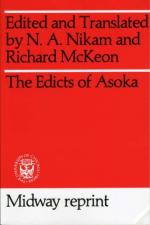|
This section contains 4,281 words (approx. 15 pages at 300 words per page) |

|
AŚOKA (Skt.; Pali and Prakrit, Asoka), the third and most powerful of the Mauryan emperors who once dominated the Indian subcontinent (fourth to third centuries BCE), figures centrally in historical as well as legendary accounts of the early Buddhist community's transformation into a world religion. Aśoka's landmark reign (c. 270–230 BCE) laid important structural foundations for subsequent south Asian imperial formation and corresponding transregional Buddhist networks, while his memory has continued to inspire and shape Buddhist practices and politics into modern times.
Scholars possess invaluable evidence for reconstruction of Aśokan history in the form of proclamations issued in Aśoka's own voice and inscribed on rocks, stone slabs, and ornate carved pillars that have survived in scattered places throughout what was once Aśoka's empire, spreading from central India to the Northwest Frontier province of Pakistan. These inscriptions, which are...
|
This section contains 4,281 words (approx. 15 pages at 300 words per page) |

|


